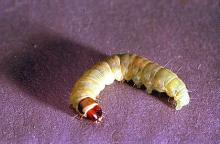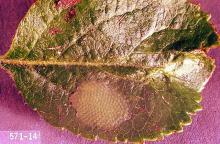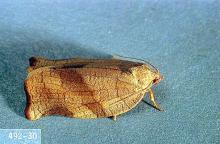Choristoneura rosaceana
Adults of the obliquebanded leafroller are bell-shaped, up to 1 inch long, tan to brown, with broad bands on the wings. The larvae are green caterpillars with a light brown to black head. As the name leafroller implies, the larvae roll and tie leaves together for shelter and feeding. They thrash about violently when disturbed, and may drop from the leaf suspended by a silken thread. Their feeding on growing points on young plants can promote undesirable branching.
Biology and life history The obliquebanded leafroller overwinters as immature larvae under the bark on scaffold branches of a variety of host plants. Larvae may feed during warm periods in winter, but become active in spring with onset of new growth. They feed for several weeks, then pupate in rolled leaves. Adult moths emerge in late June or early July. These lay eggs for the second generation. The second generation hatches in early July and does the most damage.
Scouting and thresholds Start sampling for leafrollers in mid-April. Examine the terminal clusters for tightly rolled leaves and feeding damage on new growth.
Management-biological control
See:
Biological Control of Nursery Pests
Very low temperatures in winter significantly reduce overwintering populations of larvae. Spiders and parasitic wasps, as well as predators like the brown lacewing, greatly reduce leafroller populations throughout the year.
Management-cultural control
Hand-pick rolled leaves containing larvae or pupae. Removal of overwintering sites, such as rolled leaves on the ground or plastered to plants, can reduce next year's population.
Management-chemical control
See:
Chemical Control of Nursery Pests
Several applications may be needed during season. Do not apply to bloom.
For more information
Johnson, W.T. and H.H. Lyon (1991), Insects That Feed on Trees and Shrubs, 2nd ed., Cornell University Press (p. 216).




